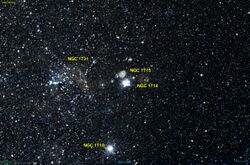Astronomy:NGC 1714
From HandWiki
Short description: Emission nebula in Dorado
| Emission nebula | |
|---|---|
 | |
| Observation data: J2000 epoch | |
| Right ascension | 04h 52m |
| Declination | ±66° 55′ |
| Apparent magnitude (V) | 11.61 |
| Apparent dimensions (V) | 1.1 arcmin |
| Constellation | Dorado |
NGC 1714 is an emission nebula in the constellation of Dorado.[1][2] It is located in the Large Magellanic Cloud[3] and was discovered by John Herschel on 2 November 1834.[4] A study investigating the chemical composition of HII regions in the Large Magellanic Cloud was conducted in it, finding a larger deuterium density than previously thought, leading to (with current knowledge) larger than accepted age of the universe.[5] Candidates for planetary nebula have also been found in the vicinity of NGC 1714.[6]
References
- Q938880. (2019, February 28). Wikidata. Retrieved 11:38, March 16, 2019 from https://www.wikidata.org/w/index.php?title=Q938880&oldid=869778701.
- ↑ "Monochromatic observations of three nebular objects in the direction of NGC 1714". https://www.researchgate.net/publication/248771129.
- ↑ Ford, Dominic. "The emission NGC 1714 - In-The-Sky.org" (in en). https://in-the-sky.org/data/object.php?id=NGC1714.
- ↑ "NGC 1714". http://simbad.u-strasbg.fr/simbad/sim-id?Ident=NGC+1714&submit=submit+id.
- ↑ "New General Catalog Objects: NGC 1700 - 1749". https://cseligman.com/text/atlas/ngc17.htm#1714.
- ↑ Piembert, Manuel (May 1974). "Chemical composition of H II regions in the Large Magellanic Cloud and its cosmological implications". The Astrophysical Journal 193: 327. doi:10.1086/153166.
- ↑ Louise, R.; Maurice (August 1984). "Monochromatic observations of three nebular objects in the direction of NGC 1714". Astrophysics and Space Science 103: 195–197. doi:10.1007/BF00650056.
 |

